Effects of Sanguis Draconis on Perforator Flap Survival in Rats
Abstract
:1. Introduction
2. Results and Discussion
2.1. Quality Control of EESD
2.2. Effect of EESD on Perforator Flap Survival
2.3. EESD’s Effect on Flap Perfusion
2.4. EESD’s Effect on the Vascularization of the Perforator Flap
2.5. EESD’s Effect on the Expression of VEGF in the Skin Flap
2.6. EESD’s Effect on Superoxide Dismutase and Malondialdehyde Levels
2.7. Discussion
3. Experimental Section
3.1. Materials and Chemicals
3.2. Animals and Groups
3.3. Preparation of Ethanol Extract of Sanguis Draconis (EESD)
3.4. Perforator Flap Animal Model and EESD Administration
3.5. General Observation and Flap Assessment
3.6. Measurement of Perfusion Values with Laser Doppler Flowmetry
3.7. Hematoxylin and Eosin Staining
3.8. Immunohistochemistry
3.9. Superoxide Dismutase Activity and Malondialdehyde Content
3.10. Statistical Analysis
4. Conclusions
Acknowledgments
Author Contributions
Conflicts of Interest
References
- Bravo, F.G.; Schwarze, H.P. Free-style local perforator flaps: Concept and classification system. J. Plast. Reconstr. Aesthet. Surg. 2009, 62, 602–608. [Google Scholar] [CrossRef] [PubMed]
- Koshima, I.; Soeda, S. Inferior epigastric artery skin flaps without rectus abdominis muscle. Br. J. Plast. Surg. 1989, 42, 645–648. [Google Scholar] [CrossRef]
- Hamdi, M.; Craggs, B.; Stoel, A.M.; Hendrickx, B.; Zeltzer, A. Superior epigastric artery perforator flap: Anatomy, clinical applications, and review of literature. J. Reconstr. Microsurg. 2014, 30, 475–482. [Google Scholar] [PubMed]
- Ammar, A.D.; Bissell, M.B.; Alejandro, M.M.; Steven, F.M. Anatomical Study of the Princeps Pollicis Artery Perforator Flap. Ann. Plast. Surg. 2016, 76, 564–568. [Google Scholar]
- Wei, F.C.; Jain, V.; Suominen, S.; Chen, H.C. Confusion among perforator flaps: What is a true perforator flap? Plast. Reconstr. Surg. 2001, 107, 874–876. [Google Scholar] [CrossRef] [PubMed]
- Fichter, A.M.; Borgmann, A.; Ritschl, L.M.; Mitchella, D.A.; Wagenpfeilb, S.; Dornseifera, U.; Wolffa, K.; Mückea, T. Perforator flaps-how many perforators are necessary to keep a flap alive? Br. J. Oral 2014, 52, 432–437. [Google Scholar] [CrossRef] [PubMed]
- Chinese Pharmacopoeia Commission. Pharmacopoeia of the People’s Republic of China; China Chemical Industry Press: Beijing, China, 2015; Volume 88. [Google Scholar]
- Xin, N.; Li, Y.J.; Li, Y.; Dai, R.J.; Meng, W.W.; Chen, Y.; Schlappi, M.; Deng, Y.L. Dragon’s Blood extract has antithrombotic properties, affecting platelet aggregation functions and anticoagulation activities. J. Ethnopharmacol. 2011, 135, 510–514. [Google Scholar] [CrossRef] [PubMed]
- Chang, Y.; Chang, T.C.; Lee, J.J.; Chang, N.C.; Huang, Y.K.; Choy, C.S.; Jayakumar, T. Sanguis draconis, a Dragon’s Blood Resin, Attenuates High Glucose-Induced Oxidative Stress and Endothelial Dysfunction in Human Umbilical Vein Endothelial Cells. Sci. World J. 2014, 2014, 423259. [Google Scholar] [CrossRef] [PubMed]
- Hu, C.M.; Li, J.S.; Cheah, K.P.; Lin, C.W.; Yu, W.Y.; Chang, M.L.; Yeh, G.C.; Chen, S.H.; Cheng, H.W.; Choy, C.S. Effect of Sanguis draconis (a dragon’s blood resin) on streptozotocin- and cytokine-induced β-cell damage, in vitro and in vivo. Diabetes Res. Clin. Pract. 2011, 94, 417–425. [Google Scholar] [CrossRef] [PubMed]
- Liu, H.H.; Lin, S.H.; Xiao, D.; Zheng, X.; Gu, Y.; Guo, S.Y. Evaluation of the Wound Healing Potential of Resina Draconis (Dracaena cochinchinensis) in Animal Models. Evid. Based Complement. Altern. Med. 2013, 2013, 709865. [Google Scholar] [CrossRef] [PubMed]
- Shi, J.; Hu, R.; Lu, Y.; Sun, C.; Wu, T. Single-step purification of dracorhodin from dragon’s blood resin of Daemonorops draco using high-speed counter-current chromatography combined with pH modulation. J. Sep. Sci. 2009, 32, 4040–4047. [Google Scholar] [CrossRef] [PubMed]
- Reichenberger, M.A.; Heimer, S.; Schaefer, A.; Lass, U.; Gebhard, M.M.; Germann, G.; Engel, H.; Köllensperger, E.; Leimer, U.; Mueller, W. Extracorporeal shock wave treatment protects skin flaps against ischemia-reperfusion injury. Injury 2012, 43, 374–380. [Google Scholar] [CrossRef] [PubMed]
- Wang, Y.; Zhao, L.; Lu, F.; Yang, X.; Deng, Q.C.; Ji, B.P.; Huang, F.H. Retinoprotective Effects of Bilberry Anthocyanins via Antioxidant, Anti-Inflammatory, and Anti-Apoptotic Mechanisms in a Visible Light-Induced Retinal Degeneration Model in Pigmented Rabbits. Molecules 2015, 20, 22395–22410. [Google Scholar] [CrossRef] [PubMed]
- Kang, M.K.; Lim, S.S.; Lee, J.Y.; Yeo, K.M.; Kang, Y.H. Anthocyanin-rich purple corn extract inhibit diabetes-associated glomerular angiogenesis. PLoS ONE 2013, 8, e79823. [Google Scholar] [CrossRef] [PubMed]
- Zhang, P.H.; Lia, J.; Tang, X.D.; Zhang, J.L.; Liang, J.; Zeng, G.F. Dracorhodin perchlorate induces apoptosis in primary fibroblasts from human skin hypertrophic scars via participation of caspase-3. Eur. J. Pharmacol. 2014, 728, 82–92. [Google Scholar] [CrossRef] [PubMed]
- Rasul, A.; Ding, C.; Li, X.M.; Khan, M.; Yi, F.; Ali, M.; Ma, T.H. Dracorhodin perchlorate inhibits PI3K/Akt and NF-κB activation, up-regulates the expression of p53, and enhances apoptosis. Apoptosis 2012, 17, 1104–1119. [Google Scholar] [CrossRef] [PubMed]
- Aksakal, I.A.; Küçüker, I.; Önger, M.E.; Engin, M.S.; Keleş, M.K.; Demir, A. The Effect of Epigallocatechin Gallate on Flap Viability of Rat Perforator Abdominal Flaps. J. Reconstr. Microsurg. 2016, 32, 256–261. [Google Scholar] [CrossRef] [PubMed]
- Sönmez, T.T.; Al-Sawaf, O.; Brandacher, G.; Kanzler, I.; Tuchscheerer, N.; Tohidnezhad, M.; Kanatas, A.; Knobe, M.; Fragoulis, A.; Tolba, R.; et al. A Novel laser Doppler flowmetry Assisted Murine Model of Acute Hindlimb Ischemia-Reperfusion for Free Flap Research. PLoS ONE 2013, 8, e66498. [Google Scholar] [CrossRef] [PubMed]
- Vandersee, S.; Erdmenger, U.; Patzelt, A.; Beyer, M.; Meinke, M.C.; Darvin, M.E.; Koscielny, J.; Lademann, J. Significance of the follicular pathway for dermal substance penetration quantified by laser Doppler flowmetry. J. Biophotonics. 2016, 9, 276–281. [Google Scholar] [CrossRef] [PubMed]
- Ganeshkumar, M.; Ponrasu, T.; Krithika, R. Topical application of Acalypha indica accelerates rat cutaneous wound healing by up-regulating the expression of Type I and III collagen. J. Ethnopharmacol. 2012, 142, 14–22. [Google Scholar] [CrossRef] [PubMed]
- Basu, G.; Downey, H.; Guo, S.; Israel, A.; Asmar, A.; Hargrave, B.; Heller, R. Prevention of distal flap necrosis in a rat random skin flap model by gene electro transfer delivering VEGF (165) plasmid. J. Gene Med. 2014, 16, 55–65. [Google Scholar] [CrossRef] [PubMed]
- Pantazia, E.; Bejaouia, M.; Folch-Puya, E.; Adamb, R.; Roselló-Catafaua, J. Advances in treatment strategies for ischemia reperfusion injury. Expert Opin. Pharmacother. 2016, 17, 169–179. [Google Scholar] [CrossRef] [PubMed]
- Kandhare, A.D.; Alam, J.; Patil, M.V.K.; Sinha, A.S.L. Bodhankar Wound healing potential of naringin ointment formulation via regulating the expression of inflammatory, apoptotic and growth mediators in experimental rats. Pharm. Biol. 2015, 54, 419–432. [Google Scholar] [CrossRef] [PubMed]
- Vourtsis, S.A.; Spyriounis, P.K.; Agrogiannis, G.D.; Ionac, M.; Papalois, A.E. VEGF Application on Rat Skin Flap Survival. J. Investig. Surg. 2012, 25, 14–19. [Google Scholar] [CrossRef] [PubMed]
- Du, X.L.; Ou, X.H.; Song, T.; Zhang, W.T.; Cong, F.; Zhang, S.H.; Xiong, Y.M. Adenosine A2B receptor stimulates angiogenesis by inducing VEGF and eNOS in human microvascular endothelial cells. Exp. Biol. Med. 2015, 12, 1–8. [Google Scholar] [CrossRef] [PubMed]
- Lu, Z.Y.; Li, R.L.; Zhou, H.S.; Huang, J.J.; Qi, J.; Su, Z.X.; Zhang, L.; Li, Y.; Shi, Y.Q.; Hao, C.N.; et al. Rescue of hypertension-related impairment of angiogenesis by therapeutic ultrasound. Am. J. Transl. Res. 2016, 8, 3087–3096. [Google Scholar] [PubMed]
- Xiao, Y.D.; Liu, Y.Q.; Li, J.L.; Ma, X.M.; Wang, Y.B.; Liu, Y.F.; Zhang, M.Z.; Zhao, P.X.; Xie, F.; Deng, X.Z. Hyperbaric oxygen preconditioning inhibits skin flap apoptosis in a rat ischemia-reperfusion model. J. Surg. Res. 2015, 199, 732–739. [Google Scholar] [CrossRef] [PubMed]
- Koyama, H.; Nojiri, H.; Kawakami, S.; Sunagawa, T.; Shirasawa, T.; Shimizu, T. Antioxidants Improve the Phenotypes of Dilated Cardiomyopathy and Muscle Fatigue in Mitochondrial Superoxide Dismutase-Deficient Mice. Molecules 2013, 18, 1383–1393. [Google Scholar] [CrossRef] [PubMed]
- Oshikawa, J.; Urao, N.; Kim, H.W.; Kaplan, N.; Razvi, M.; McKinney, R.; Poole, L.B.; Fukai, T.; Masuko, U.F. Extracellular SOD-Derived H2O2 Promotes VEGF Signaling in Caveolae/Lipid Rafts and Post-Ischemic Angiogenesis in Mice. PLoS ONE 2010, 5, e1018931. [Google Scholar] [CrossRef] [PubMed]
- Zhang, L.; Ma, J.W.; Liu, H.J. Protective Effect of Ischemic Postconditioning against Ischemia Reperfusion-Induced Myocardium Oxidative Injury in IR Rats. Molecules 2012, 17, 3805–3817. [Google Scholar] [CrossRef] [PubMed]
- Cui, J.; Liu, L.; Zou, J.; Qiao, W.L.; Liu, H.; Qi, Y.J.; Yan, C.D. Protective effect of endogenous hydrogen sulfide against oxidative stress in gastric ischemia-reperfusion injury. Exp. Ther. Med. 2013, 5, 689–694. [Google Scholar] [PubMed]
- Hallock, G.G.; Rice, D.C. Cranial Epigastric Perforator Flap: A Rat Model of a True Perforator Flap. Ann. Plast. Surg. 2003, 50, 393–397. [Google Scholar] [CrossRef] [PubMed]
- Yuen, J.C.; Feng, Z. Monitoring free flaps using the laser Doppler flowmetry: Five-year experience. Plast. Reconstr. Surg. 2000, 105, 55. [Google Scholar] [CrossRef] [PubMed]
- Ozkan, F.; Senayli, Y.; Ozyurt, H.; Erkorkmaz, U.; Bostan, B. Antioxidant effects of propofol on tourniquet-induced ischemia-reperfusion injury: An experimental study. J. Surg. Res. 2012, 176, 601–607. [Google Scholar] [CrossRef] [PubMed]
- Sample Availability: Samples of the compounds ethanol extract of sanguis draconis (EESD) are available from the authors.
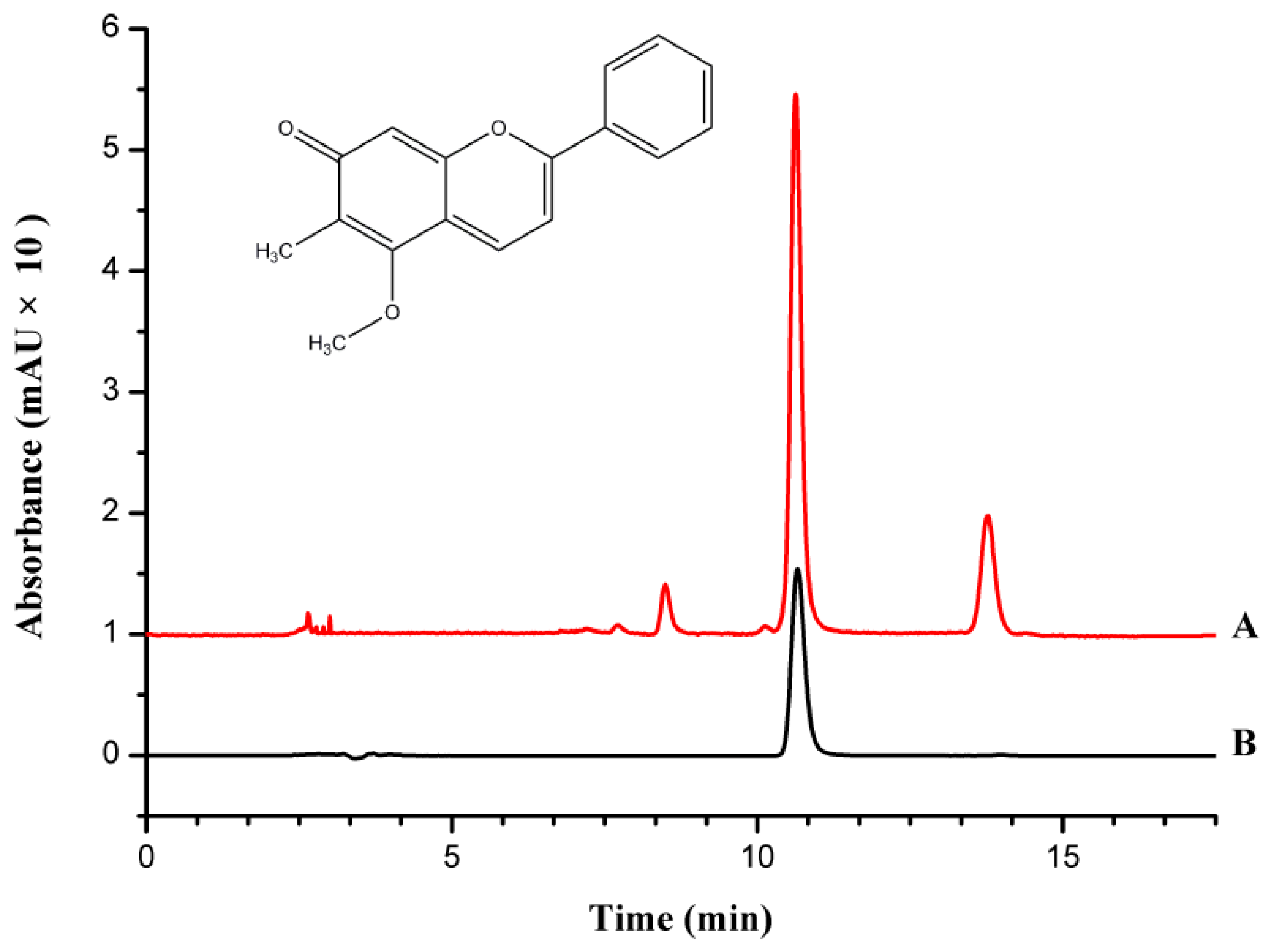
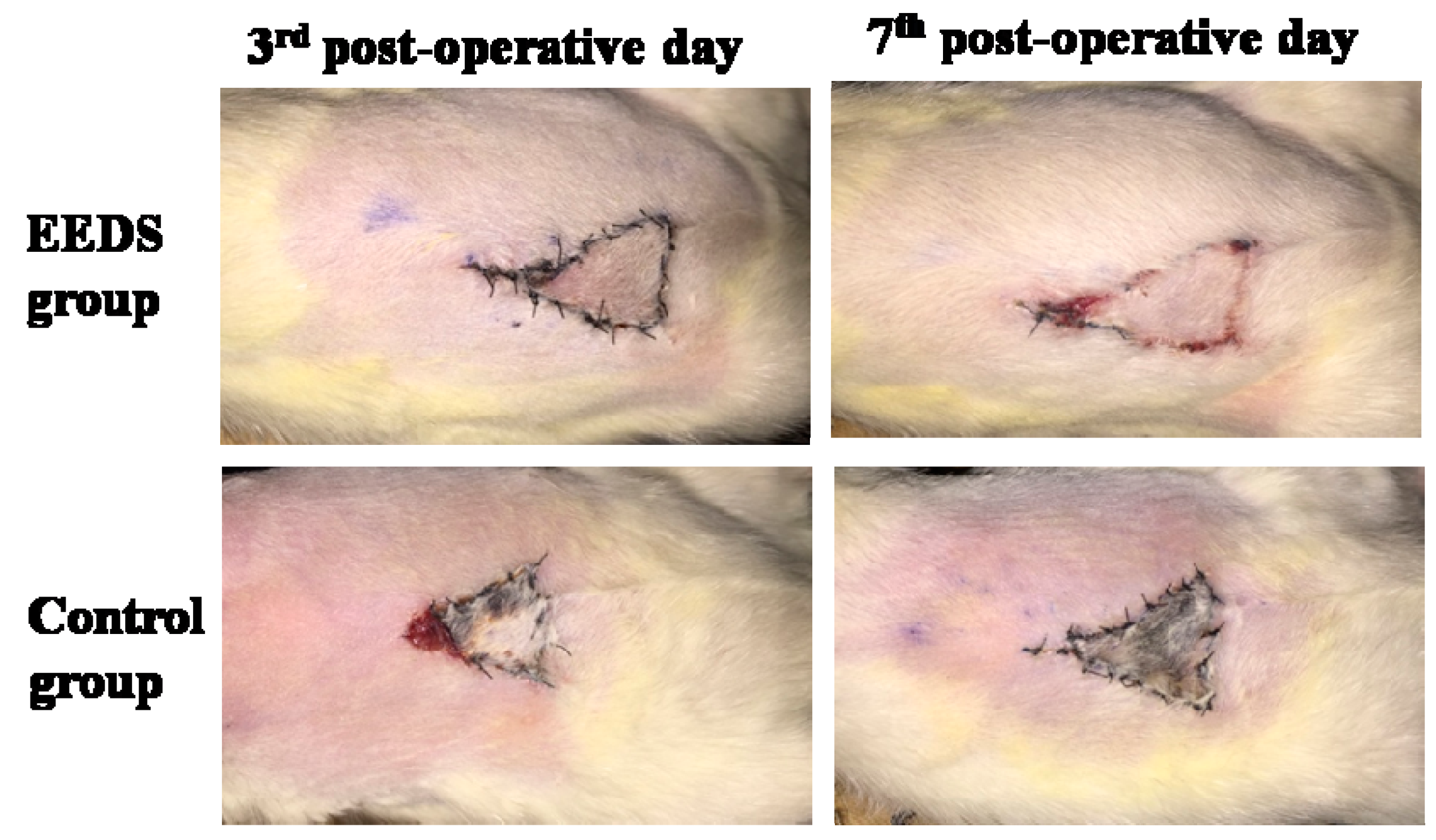
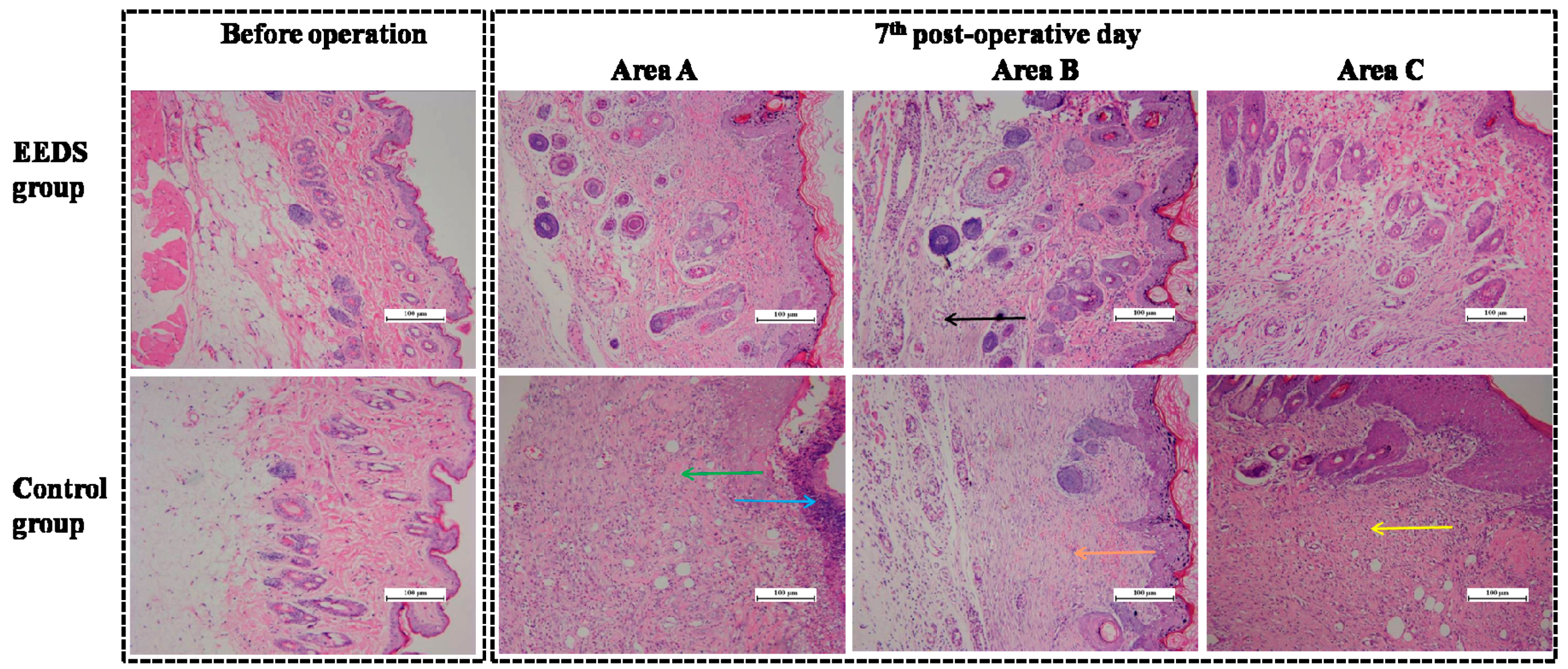
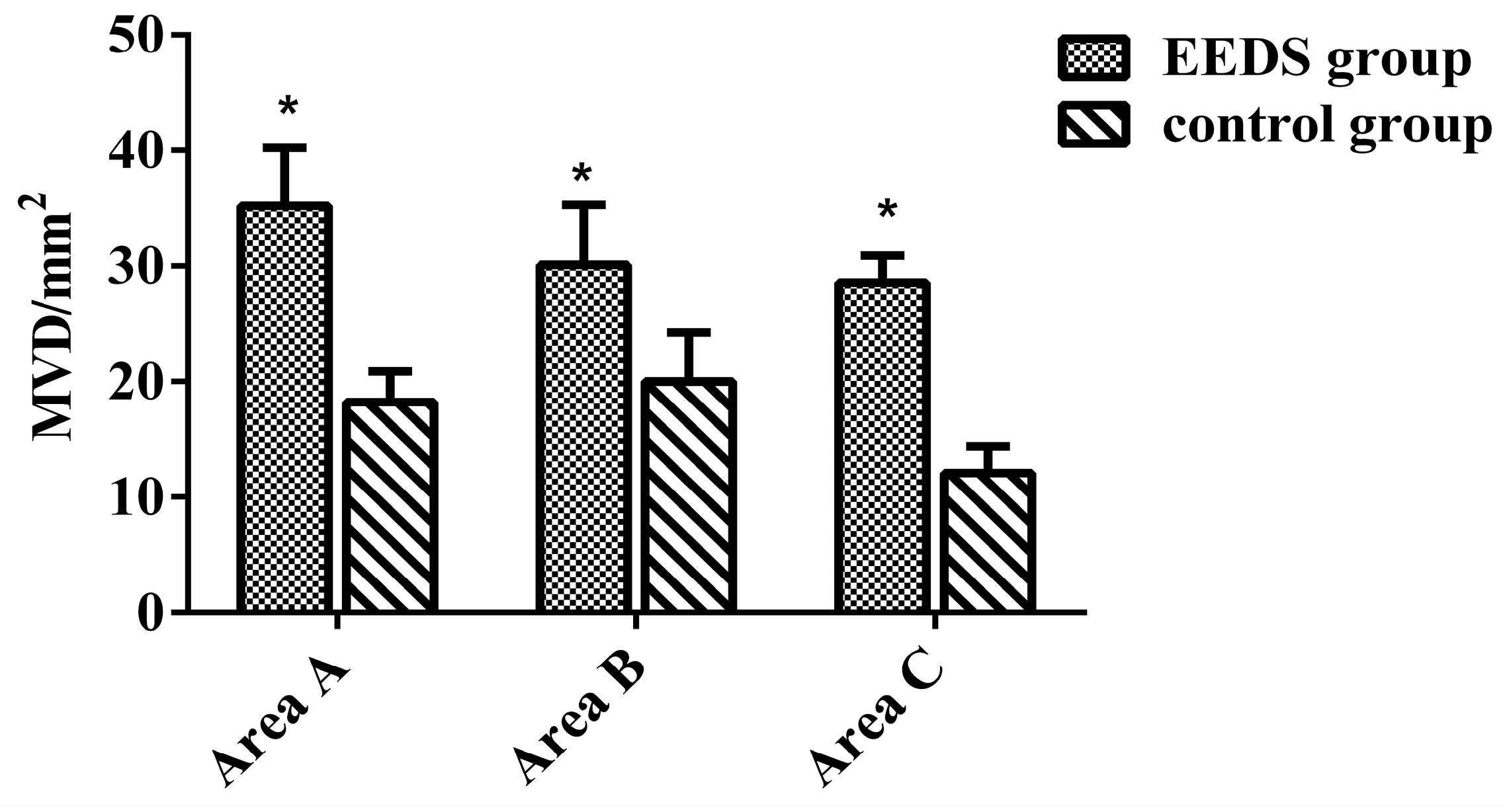

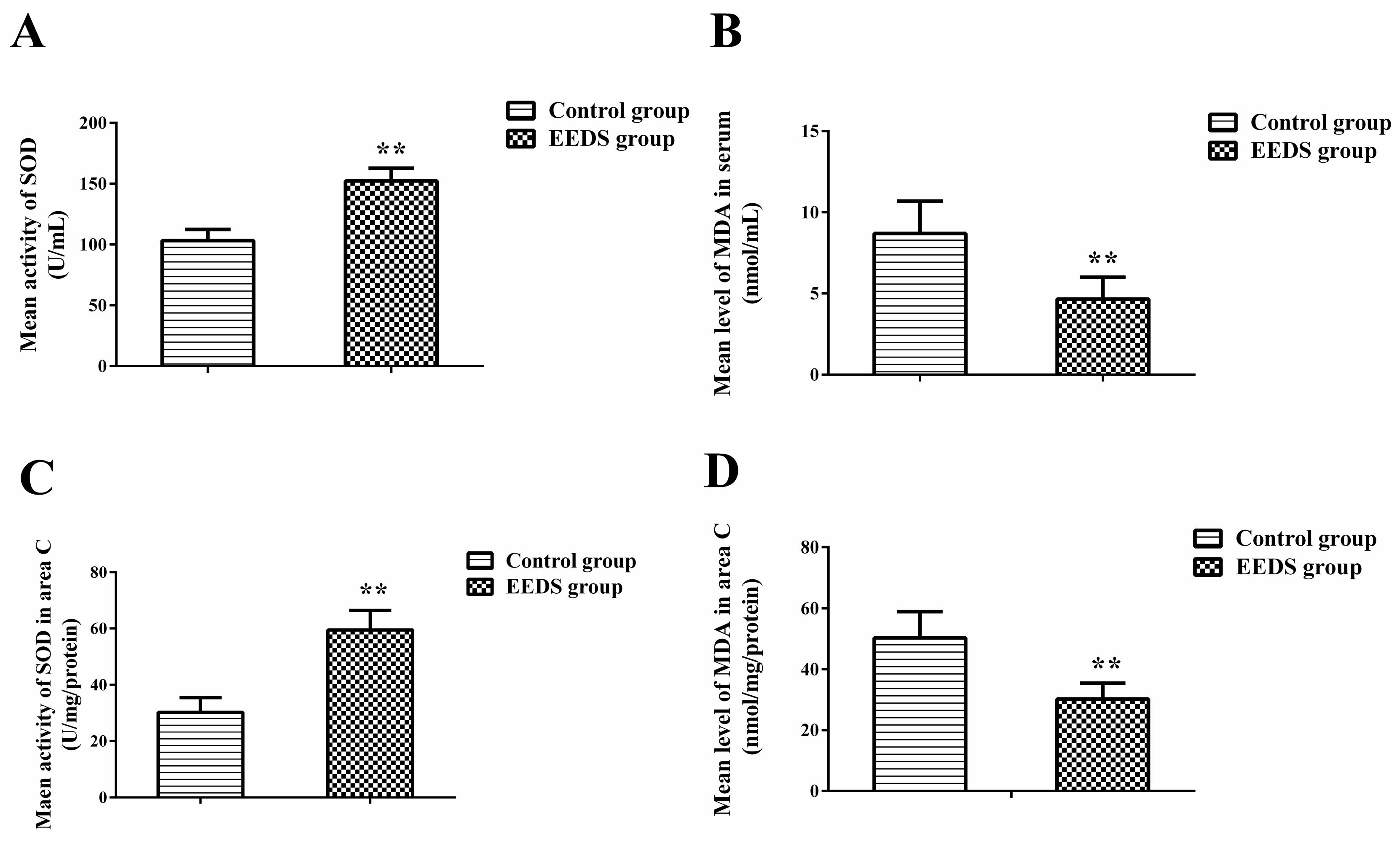
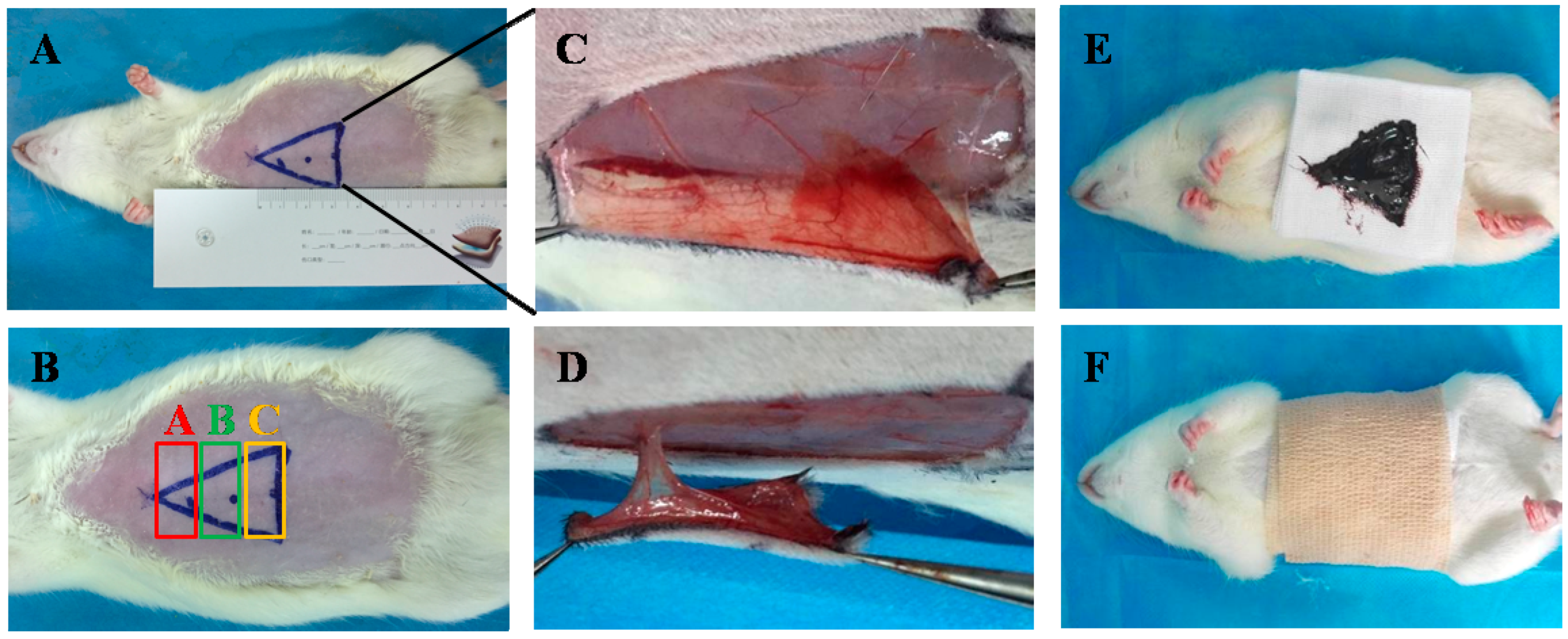
| Group | Proportion of Survival Area (%) | |
|---|---|---|
| 3rd Post-Operative Day | 7th Post-Operative Day | |
| EESD group | 82.32 ± 3.07 * | 98.02 ± 3.21 |
| Control group | 60.05 ± 2 # | 5.36 ± 0.52 |
| Time | EESD Group | Control Group | ||||
|---|---|---|---|---|---|---|
| Area A | Area B | Area C | Area A | Area B | Area C | |
| Before operation | 46.25 ± 2.14 | 50.23 ± 3.01 | 48.12 ± 2.86 | 48.32 ± 2.46 | 51.36 ± 3.69 | 49.65 ± 3.47 |
| 1 day after operation | 59.61 ± 2.04 ※ | 48.69 ± 1.38 * | 51.27 ± 3.46 *,# | 56.33 ± 2.91 ※ | 33.26 ± 2.52 ▲ | 22.64 ± 2.01 ▲ |
| 7 day after operation | 65.86 ± 1.47 *,#,※ | 60.85 ± 4.61 *,#,※ | 58.41 ± 4.07 *,#,※ | 43.95 ± 3.81 | 10.67 ± 1.56 ▲ | 10.57 ± 1.40 ▲ |
© 2016 by the authors. Licensee MDPI, Basel, Switzerland. This article is an open access article distributed under the terms and conditions of the Creative Commons Attribution (CC-BY) license ( http://creativecommons.org/licenses/by/4.0/).
Share and Cite
Zhang, Y.; Cai, X.; Shen, L.; Huang, X.; Wang, X.; Lan, Y.; Shou, D. Effects of Sanguis Draconis on Perforator Flap Survival in Rats. Molecules 2016, 21, 1262. https://doi.org/10.3390/molecules21101262
Zhang Y, Cai X, Shen L, Huang X, Wang X, Lan Y, Shou D. Effects of Sanguis Draconis on Perforator Flap Survival in Rats. Molecules. 2016; 21(10):1262. https://doi.org/10.3390/molecules21101262
Chicago/Turabian StyleZhang, Yang, Xiaobing Cai, Lifeng Shen, Xiaowen Huang, Xuping Wang, Yinan Lan, and Dan Shou. 2016. "Effects of Sanguis Draconis on Perforator Flap Survival in Rats" Molecules 21, no. 10: 1262. https://doi.org/10.3390/molecules21101262






